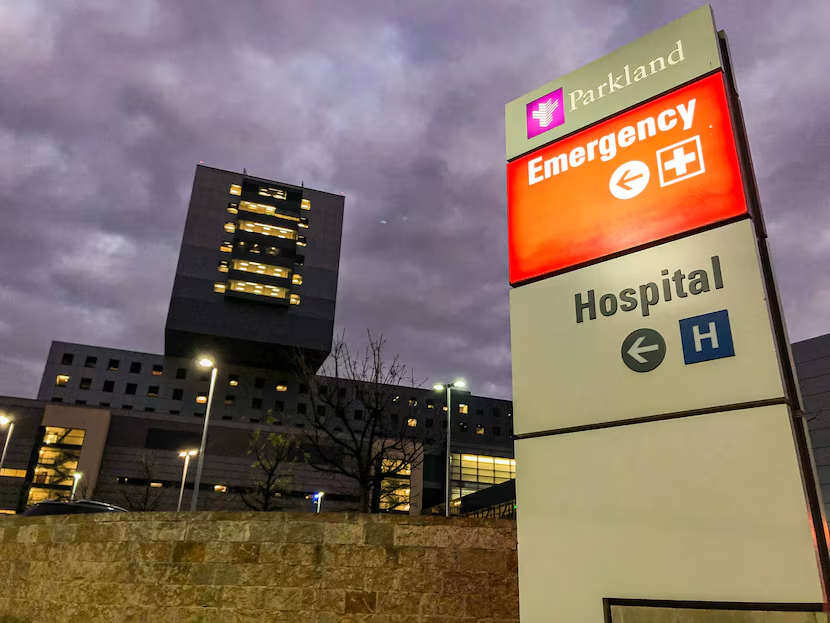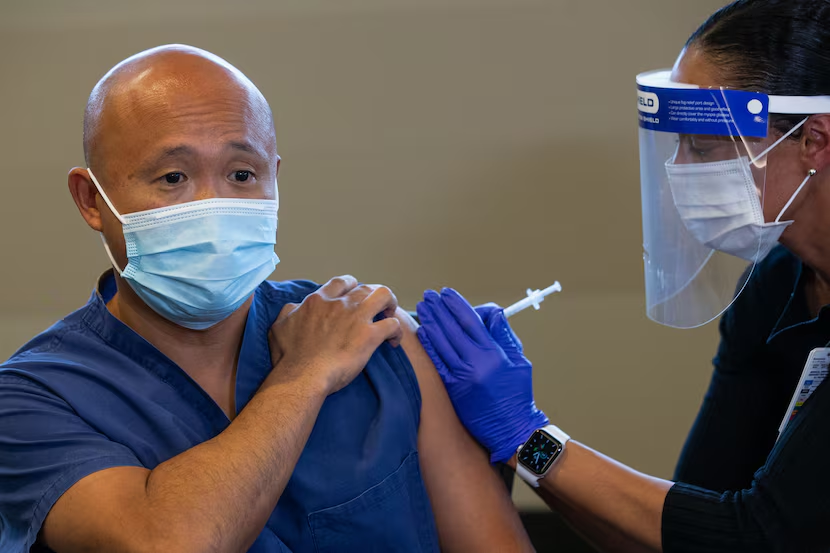Dallas County’s public hospital is at a dire tipping point, with more COVID-19 patients than at any time during the pandemic and more intensive care patients than it has ever served, health officials said Tuesday.
“At this point, we’re completely full,” said Dr. Joseph Chang, Parkland Health & Hospital System’s chief medical officer. “We’re overfull.”
Parkland Memorial Hospital, like other Dallas-area hospitals, is seeing an unprecedented number of COVID-19 patients and rapidly shrinking bed capacity — pushing already worn-out nurses, doctors and other hospital staff members to the brink. Ultimately, this extended surge could lead to staffing shortages and affect patients’ quality of care.
On Tuesday, only 31 adult intensive care beds were available in Dallas and Tarrant counties, according to state data provided to the news media from the Dallas-Fort Worth Hospital Council. That’s a fraction of the more than 300 beds that were available in Dallas alone last spring at the dawn of the pandemic.
And for the second day in a row, Texas set a record for the number of COVID-19 patients in hospitals across the state. Tuesday, there were 11,775.
Hospital data, including the number of COVID patients, available beds and coronavirus-related emergency room visits, has become vital in monitoring the pandemic. While the reporting is not perfect, public health officials and politicians consider it more reliable, timely and significant than testing statistics.
“We’re well past summer levels,” Chang said. Since the summer peak, Texas hospitals have changed the way they count COVID cases, including only patients who are fighting symptoms of the disease caused by the coronavirus.
“What these numbers mean for the community is that they should be worried,” Chang said.

Parkland had 161 patients with active COVID-19 cases and 60 more who were recovering but need hospital-level care to treat lung or heart damage, Chang said.
Parkland had 91 intensive care patients — including non-COVID patients. Before the start of the pandemic, the hospital had 89 ICU beds. It now has 113, a number that includes pediatric, burn and other trauma patients. A year ago, Chang said, the hospital typically used 70 to 80 ICU beds at a time.
As a Level 1 trauma hospital, Parkland regularly provides care for some of the most severely injured patients in North Texas and southern Oklahoma.
The increase in COVID patients drains hospital resources from other cases, Chang said.
“COVID doesn’t exist in a vacuum,” he said. “My ability to take care of moms and babies goes down when my beds are completely full of COVID patients.”
Gov. Greg Abbott drew a red line in his last executive order, basing allowable business occupancy on how many COVID patients were in hospitals. The North Texas hospital region crossed that threshold the day after Thanksgiving and is showing no signs of retreating.
The number of new COVID-19 cases is considered sure to rise, as the spread of the virus during family Christmas gatherings produces more cases of the disease. With yet another holiday this week, health officials are bracing for what many expect to be the most difficult phase of the pandemic yet.
While the supply of hospital beds is critically low, each hospital has its own plan to add capacity, said Steve Love, president and CEO of the Dallas-Fort Worth Hospital Council. This includes setting up specific units and putting beds in other areas such as conference rooms and cafeterias.
Most common, Love said, is doubling up beds in rooms.
“We also have the final type surging such as opening buildings like hotels or old hospitals that have closed to house lower-acuity patients,” he said in a statement. “This is not ideal because you limit staff and resources when you are trying to use this space.”
What has made the winter surge so much worse than previous peaks is that the entire state and nation are in COVID’s grip simultaneously. There is little slack in the nation’s health care system to move around much-needed staff members to care for patients.

Parkland has tapped existing help, including traveling nurses and state-provided doctors. About 1,500 medical staff members have been sent to North Texas to help support hospitals, said Lara M. Anton, a spokeswoman for the Texas Department of State Health Services.
“The staffing is the most difficult part of this equation,” said Parkland’s Chang, noting that other hospitals also are running low on ICU nurses and respiratory therapy technicians.
While it’s unlikely that Parkland or other hospitals will run out of physical beds for patients, running short of staff members is a plausible concern — one that Parkland officials consider daily.
“There will be a point when I don’t have enough people,” Chang said. “We won’t turn people away.
“But yes, we’ll reach the point when we’ll have to talk about alternative levels of care. I’m talking about decreasing the number of times nurses see you, the number of times your vital signs might be checked.”
Austin bureau chief Robert T. Garrett contributed to this report.







